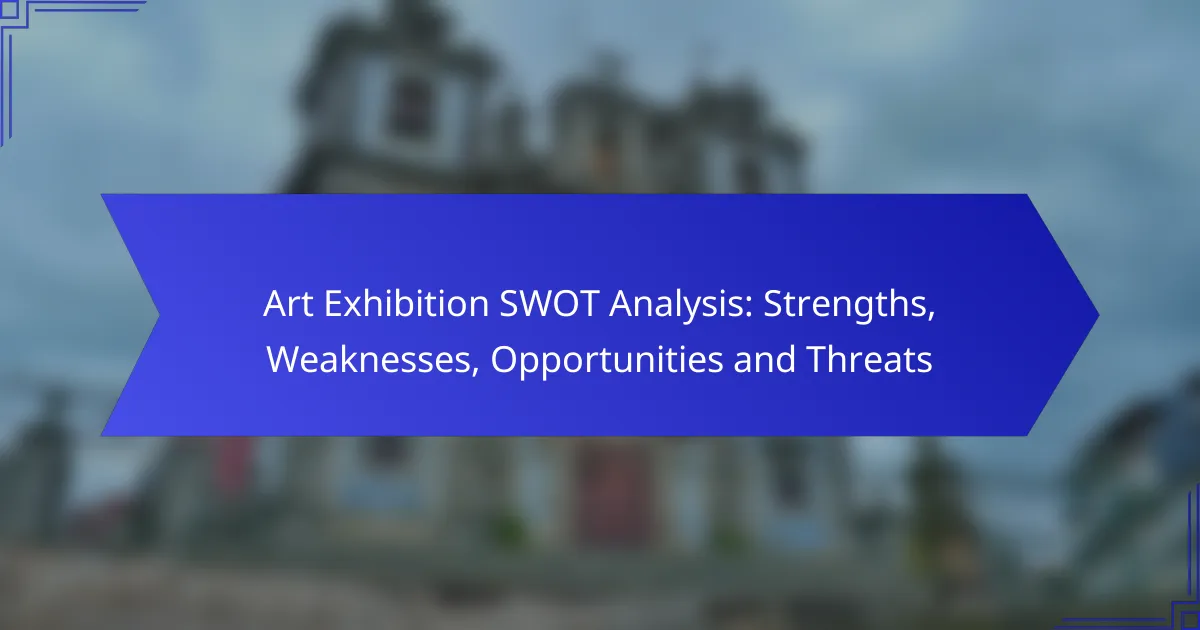An art exhibition serves as a dynamic platform that not only showcases creativity but also engages audiences and fosters valuable partnerships. However, it faces challenges such as high operational costs and limited audience reach, which can threaten its sustainability. By exploring innovative formats and leveraging online channels, art exhibitions can capitalize on opportunities to expand their impact and accessibility.

What are the strengths of art exhibitions?
Art exhibitions possess several strengths that enhance their appeal and effectiveness. They engage audiences, foster partnerships, and create memorable experiences, all of which contribute to their success in the cultural landscape.
High visitor engagement
Art exhibitions often attract large numbers of visitors, leading to high levels of engagement. Interactive installations, guided tours, and workshops can further enhance this involvement, encouraging attendees to connect with the art on a personal level.
To maximize visitor engagement, consider incorporating multimedia elements or social media interactions. For example, allowing visitors to share their experiences online can create a buzz and draw in more attendees.
Brand partnerships
Collaborating with brands can significantly enhance the visibility and resources available for an art exhibition. These partnerships can provide financial support, marketing assistance, and access to a broader audience.
When seeking brand partnerships, target companies that align with the exhibition’s theme or values. For instance, a contemporary art show might partner with a tech company to showcase innovative digital art, benefiting both parties.
Unique artistic experiences
Art exhibitions offer unique experiences that cannot be replicated elsewhere, such as immersive installations or live performances. These experiences can leave a lasting impression on visitors, making them more likely to return or recommend the exhibition to others.
To create memorable artistic experiences, consider incorporating elements that engage multiple senses, such as soundscapes or tactile installations. This approach can elevate the overall impact of the exhibition.
Diverse audience appeal
Art exhibitions can attract a wide range of audiences, from art enthusiasts to casual visitors. This diversity can enhance discussions and broaden perspectives, enriching the overall experience for everyone involved.
To appeal to various demographics, curate a mix of traditional and contemporary works, and offer programs that cater to different interests, such as family-friendly activities or educational workshops for students.
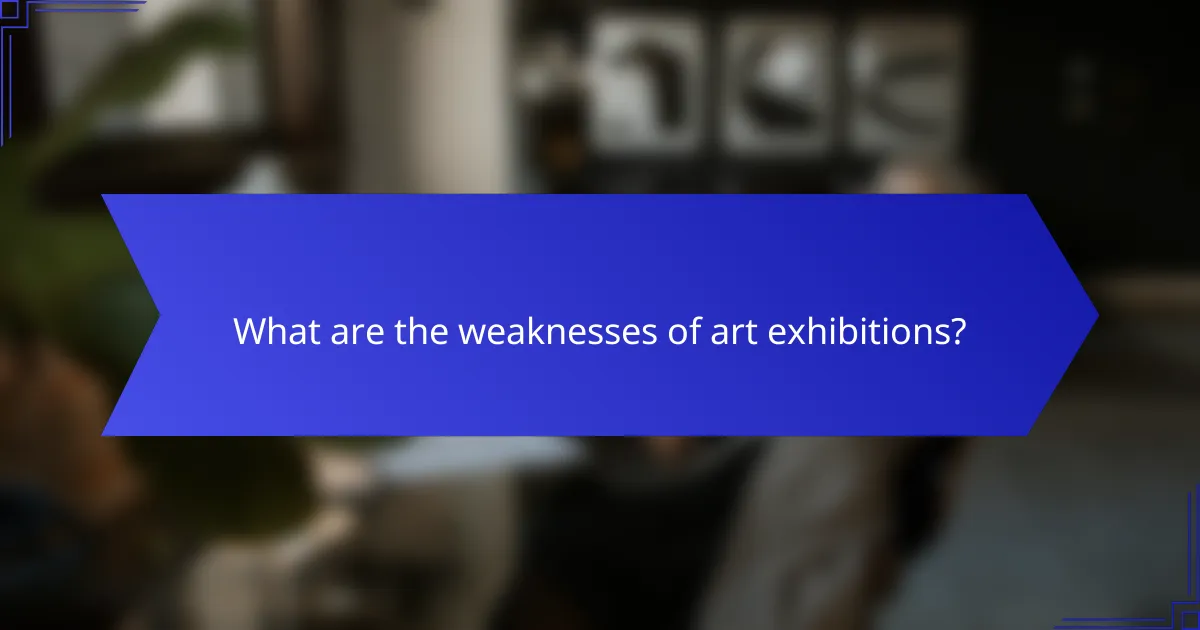
What are the weaknesses of art exhibitions?
Art exhibitions face several weaknesses that can hinder their success. These include high operational costs, limited audience reach, and a dependency on sponsorship, all of which can impact the overall viability and sustainability of the event.
High operational costs
One significant weakness of art exhibitions is the high operational costs involved. Expenses can include venue rental, insurance, transportation of artworks, and marketing efforts. These costs can quickly add up, often reaching tens of thousands of dollars, which can strain budgets, especially for smaller galleries or independent artists.
To manage these costs, organizers should consider partnering with local businesses for shared resources or seeking grants specifically aimed at supporting the arts. Additionally, early budgeting and careful planning can help mitigate unexpected expenses.
Limited audience reach
Art exhibitions often struggle with limited audience reach, which can restrict their impact and profitability. Factors such as location, timing, and marketing efforts play a crucial role in determining how many people attend. For instance, exhibitions held in remote areas may attract fewer visitors compared to those in urban centers.
To enhance audience reach, organizers should leverage social media and online platforms to promote events widely. Collaborating with local influencers or community organizations can also help draw in diverse crowds and increase visibility.
Dependency on sponsorship
Many art exhibitions rely heavily on sponsorship to cover costs, which can create vulnerabilities. If sponsors withdraw or reduce their support, it can jeopardize the exhibition’s financial stability. This dependency can also lead to compromises in artistic integrity if sponsors influence the content or direction of the exhibition.
To reduce this risk, organizers should seek a diverse range of funding sources, including ticket sales, merchandise, and crowdfunding. Building strong relationships with multiple sponsors can also provide a safety net against potential financial shortfalls.

What opportunities exist for art exhibitions?
Art exhibitions have numerous opportunities to enhance engagement and reach wider audiences. These include adopting innovative formats, fostering collaborations, and leveraging online sales channels.
Virtual exhibition formats
Virtual exhibition formats allow galleries to showcase art beyond physical limitations. By utilizing online platforms, exhibitions can reach global audiences, providing immersive experiences through 3D tours or live-streamed events.
Consider investing in user-friendly technology that enhances viewer interaction. Tools like virtual reality (VR) or augmented reality (AR) can create memorable experiences, making art accessible to those unable to attend in person.
Collaborations with local artists
Collaborating with local artists can enrich an exhibition’s appeal and foster community engagement. Such partnerships can lead to unique, culturally relevant displays that resonate with local audiences.
To maximize this opportunity, consider hosting joint events or workshops that highlight local talent. This not only supports artists but also attracts their followers, expanding your exhibition’s reach.
Expanding online ticket sales
Expanding online ticket sales is a crucial opportunity for art exhibitions to increase revenue and accessibility. By offering tickets through various online platforms, exhibitions can tap into a broader audience base.
Implementing tiered pricing or early-bird discounts can incentivize purchases. Ensure your website is optimized for mobile devices to facilitate easy access and transactions, as many users prefer purchasing tickets on their smartphones.
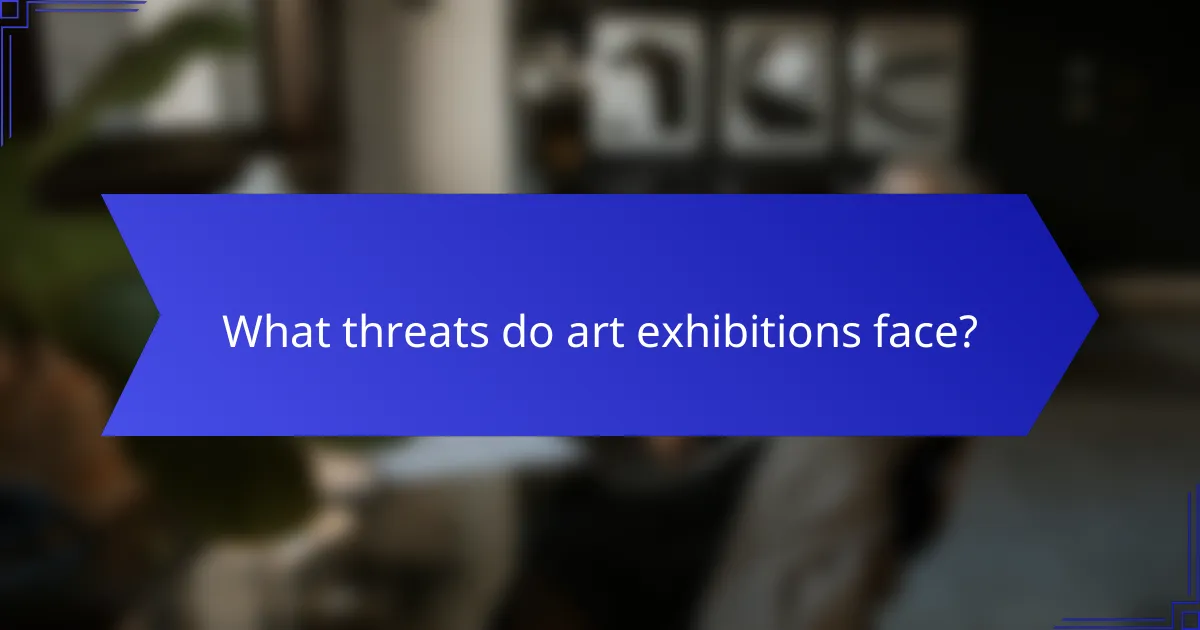
What threats do art exhibitions face?
Art exhibitions encounter various threats that can impact attendance, funding, and overall success. Key threats include economic downturns, competition from digital media, and changing audience preferences.
Economic downturns
Economic downturns pose a significant threat to art exhibitions as they often lead to reduced disposable income for potential visitors. During such periods, ticket sales may decline, and sponsorship from businesses can diminish, affecting overall budgets.
Exhibitions may need to adapt by offering lower ticket prices or special promotions to attract visitors. Collaborating with local businesses for sponsorships can also help mitigate financial impacts during tough economic times.
Competition from digital media
The rise of digital media presents a formidable challenge to traditional art exhibitions. Online platforms provide easy access to art through virtual galleries and social media, which can draw audiences away from physical events.
To counter this threat, exhibitions should consider integrating digital experiences, such as virtual tours or interactive online content, to engage audiences both online and offline. Offering exclusive in-person experiences can also entice visitors to attend live events.
Changing audience preferences
Changing audience preferences can significantly affect attendance at art exhibitions. Younger generations may prioritize interactive and immersive experiences over traditional displays, which can lead to a decline in interest for conventional exhibitions.
Exhibitors should stay attuned to trends by conducting audience surveys and incorporating feedback into their programming. Emphasizing engagement through workshops, artist talks, and community events can help align exhibitions with evolving audience expectations.
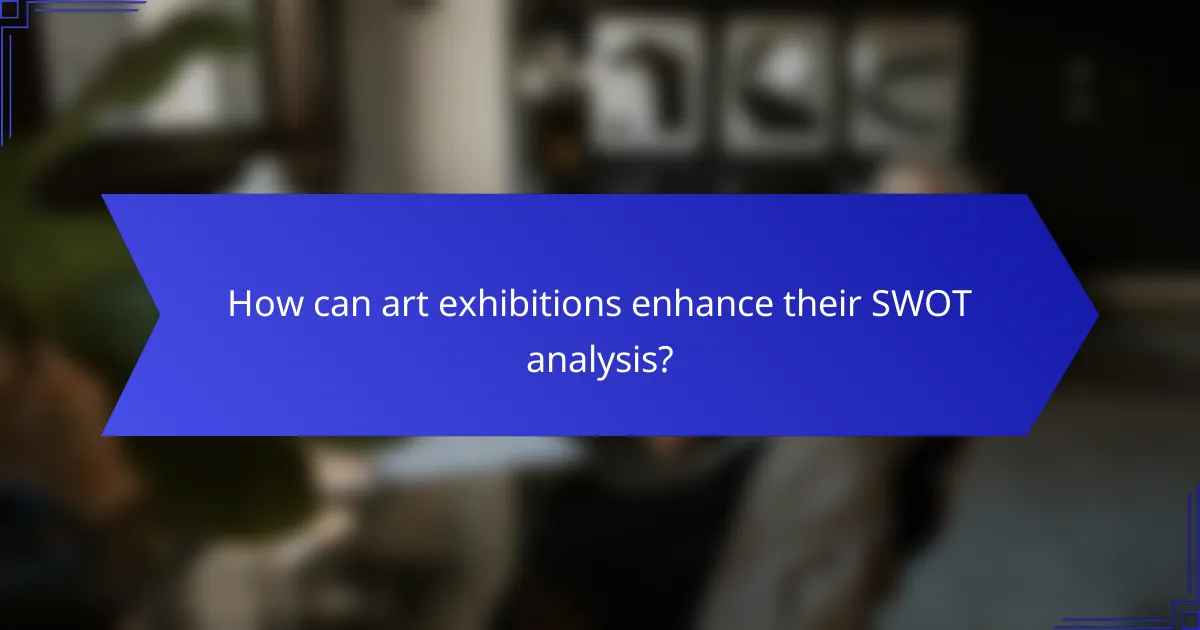
How can art exhibitions enhance their SWOT analysis?
Art exhibitions can enhance their SWOT analysis by systematically evaluating their strengths, weaknesses, opportunities, and threats. This process helps in identifying key areas for improvement and leveraging advantages to maximize audience engagement and financial success.
Regular stakeholder feedback
Gathering regular feedback from stakeholders, including artists, visitors, and sponsors, is crucial for a comprehensive SWOT analysis. This feedback can reveal insights into the exhibition’s strengths, such as popular themes or effective marketing strategies, as well as weaknesses, like logistical issues or visitor dissatisfaction.
To implement a feedback system, consider using surveys, focus groups, or informal discussions. Aim for a diverse range of opinions to capture different perspectives, and schedule these feedback sessions at key points throughout the exhibition cycle to ensure timely adjustments.
Market trend analysis
Conducting a market trend analysis allows art exhibitions to stay relevant and competitive. By examining current art trends, audience preferences, and emerging technologies, exhibitions can identify opportunities for innovative displays or new audience engagement strategies.
Utilize resources such as art market reports, social media trends, and attendance data from similar exhibitions. Regularly updating this analysis can help exhibitions adapt to changing tastes and capitalize on new opportunities, such as collaborations with popular artists or thematic events that resonate with current societal issues.
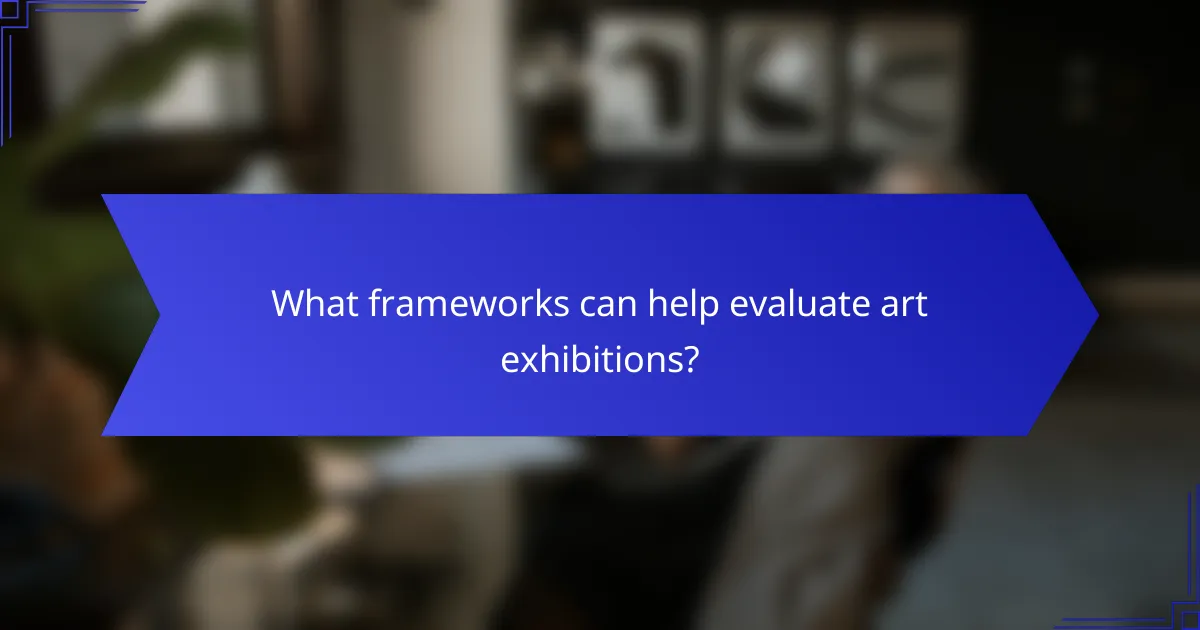
What frameworks can help evaluate art exhibitions?
Several frameworks can effectively evaluate art exhibitions, focusing on their strengths, weaknesses, opportunities, and threats (SWOT). These frameworks help organizers and stakeholders assess the overall impact and viability of an exhibition.
Strengths
Strengths refer to the internal attributes that enhance the exhibition’s appeal and effectiveness. This could include a strong reputation of the featured artists, unique themes, or innovative presentation techniques. For instance, an exhibition featuring renowned contemporary artists may attract larger audiences and media attention.
Identifying strengths helps in leveraging them for marketing and engagement strategies. Organizers should consider aspects like location, partnerships with local institutions, and community support, which can significantly boost attendance and participation.
Weaknesses
Weaknesses are internal factors that may hinder the success of an art exhibition. Common weaknesses include limited funding, inadequate marketing efforts, or poor venue accessibility. For example, an exhibition in a hard-to-reach location may struggle to attract visitors.
Addressing weaknesses is crucial for improvement. Organizers should conduct thorough assessments to identify these areas and develop strategies to mitigate them, such as enhancing outreach efforts or securing additional sponsorships.
Opportunities
Opportunities are external factors that can be leveraged to enhance the exhibition’s success. This may include emerging trends in the art world, potential collaborations with local businesses, or grants available for cultural projects. For instance, tapping into social media trends can increase visibility and engagement.
To capitalize on opportunities, organizers should stay informed about industry developments and community interests. Engaging with local artists and cultural organizations can also create synergies that enhance the exhibition’s reach and impact.
Threats
Threats are external challenges that could negatively affect the exhibition. These might include economic downturns, competition from other events, or changes in public interest. For example, a recession could lead to reduced attendance and funding for cultural events.
Understanding potential threats allows organizers to develop contingency plans. Regularly monitoring the external environment and adapting strategies can help mitigate risks and ensure the exhibition remains relevant and appealing to audiences.
